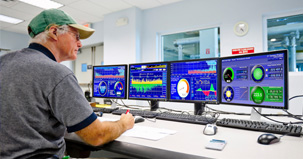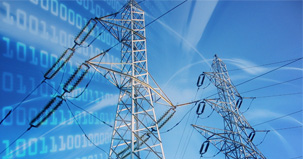- Home
- Smart Data
Smart Data
Actionable intelligence on energy and water use:
- Helps users identify inefficencies, and waste
- Provides real-time feedback on conservation
Right data for the right audience:
- Facility managers identify when and where energy is wasted
- CFO's can track and verify financial savings from initiatives
- Company knows its carbon and water footprint
Related Products
 Information any time, anywhere
Information any time, anywhere - Smart User
Smart User
Smart users leverage real-time data and reduce energy and water use by:
- Continuously identifying opportunities
- Acting on opportunities
- Tracking and verifying savings
- Sustaining savings
Related Products
 Monitor, Manage, Maintain
Monitor, Manage, Maintain - Smart Community
Smart Community
A smart community is one where all stakeholders are engaged in energy and water conservation. A smart community can be achieved by:
- Showing people precisely how much they are using
- Providing real-time feedback on conservation actions
- Effectively communicating efficiency results
Related Products
 Communicate and Conserve
Communicate and Conserve - Smart Grid
Smart Grid
Smart grid, as we define it, is a "green grid", with efficient resource use and the key to a low-carbon future. We help our customers prepare for the smart grid by:
- Engaging users with smart data
- Enabling smart users to increase resource efficiency
- Educating & empowering smart communities
Related Products
 Smart grid and a smarter future
Smart grid and a smarter future - Smart Buildings
Smart Buildings
Smart buildings maximize resource (energy, water, capital) efficiency. These buildings are optimized using energy and water management process with high data visibility which lead to reduced energy and water spending.
- Higher operating income and higher asset values for owners
- Increased productivity for occupants
- Lower carbon footprint for the community
 Resource efficient buildings
Resource efficient buildings
Subtitle!
Recent Posts
Every Breath You Take: Indoor Air Quality Must Be Monitored - Your Health Depends on It
If there’s one thing each and every one of us takes for granted, it’s the air we breathe. And, quality notwithstanding, it’s generally in plentiful supply.
It would seem rather obvious to note that clean air is critical. That’s especially true indoors, where air filtration and ventilation systems may not always be working at optimum levels. Similarly, poor indoor air quality can have a considerable impact on our overall health.
Americans, on average, spend up to 90 percent of their time indoors, according to the U.S. Environmental Protection Agency (EPA). Think about it: you spend all day at the office and then come home. Who among us spends as much time as we would like outside in the fresh air?
If the HVAC systems in your home or office aren’t functioning properly, you are spending hours breathing contaminated air. And, when you consider the fact that, every day, we are apt to breathe in carbon monoxide, ground-level ozone, lead, nitrogen dioxide, particulate matter, sulfur dioxide and others, the issue of air quality is certainly worth examination. What’s worse, even an optimized system that measures air quality is just that – a machine. Machines malfunction. The problem with contaminated air is that you may not know it’s there until you develop symptoms associated with poor air quality.
Of course, depending on where you live and work, the quality of air can be more dangerous. Smog-filled cities or areas where there are concentrations of factories clearly pose higher risks to those in the area than, perhaps, America’s Heartland of grassy fields and farms.
Regardless, indoor air quality is important wherever you are and that’s especially true if you spend countless hours in the workplace where poor air circulation can contribute to a host of maladies that can make you sick, tired and unable to be productive.
Talk about a lose-lose for employee and employer.
Is Your Building Making You Sick?
You’ve heard of sick people, but how about sick buildings? They exist and you may even be working in one right now. Sick buildings exist when a concentration of pollutants in the air is so extreme that inhabitants get routinely sick with a malady known as – what else? – Sick Building Syndrome. SBS is characterized by irritation of the eyes, nose and throat, as well as skin irritation.
There are many causes of Sick Building Syndrome, the most obvious being: inadequate ventilation; chemical contaminants from indoor sources such as adhesives, carpeting, upholstery, etc.; chemical contaminants from outdoor sources such as motor vehicle exhausts, plumbing vents, and building exhausts; and biological contaminants such as bacteria, mold, pollen, and viruses.
According to the EPA, “these elements may act in combination, and may supplement other complaints such as inadequate temperature, humidity, or lighting. Even after a building investigation, however, the specific causes of the complaints may remain unknown.”
It’s no wonder that companies located in sick buildings are seeing skyrocketing employee absenteeism. Who wants to come to work when work is making them physically ill? Additionally, poor air quality causes fatigue, according to the Environmental Protection Agency.
It almost goes without saying that absent employees are not great for business. Ka-ching! Up goes your insurance premiums; down goes productivity.
Sick Building Syndrome is just one way in which poor air quality can affect the health of your employees. There are also long-term effects to consider. The American Medical Association (AMA) determined that consistently breathing in contaminated air can cause conditions such as asthma, heart disease and even cancer. These serious effects can show themselves months or even years after an individual’s initial exposure to indoor pollutants.
The only way to mitigate the problem of poor air quality is to monitor your system, ensure adequate ventilation and act quickly to fix problem in your facility.
Knowledge is Power
This saying has never been more true. When it comes to air quality – something you just can’t measure with the naked eye – you don’t know what you don’t know.
It’s critical to make sure the indoor air quality in your home or workplace is being monitored for pollutants. The only real way of performing this task accurately is to make sure your HVAC systems are equipped with state-of-the-art, fully functioning filtration and ventilation systems.
“Monitoring air quality and acting on the information can provide a more productive work environment,” explained Dave Guralchuk, vice president of engineering at Noveda Technologies. “Monitoring CO2 levels inside a building is a good indicator about how regularly the air inside the building is being flushed out.”
Of course, when a building’s systems are being properly monitored, it’s easy to spot problems and fix them – saving time, money and resources. Few know that reality better than Dennis Hercel, director of facilities at Jersey City, N.J-based Liberty Science Center (LSC).
When the 295,000 square foot museum re-opened in 2007 after a complete renovation, LSC launched a host of energy savings initiatives including solar arrays, updated lighting equipment, and improvements to the buildings HVAC systems with the hopes of saving energy usage and costs. But, LSC executives wondered, were those green initiatives worth the investment? How could they be sure they were saving energy and reducing LSC’s energy bills?
In 2007-08, LSC reported using 10,158,516KWh at a cost of more than $1.5 million. Ay year later, LSC installed the Noveda EnergyFlow Monitor and SunFlow Monitor™ to track energy use and to monitor the performance of the facility’s solar photovoltaic system, respectively.
“It turns out that saving energy is a lot like losing weight – facilities often seek a quick fix to lower energy bills by slashing energy usage, but they can’t sustain it. A year later, they find that energy consumption has crept back up again,” LSC’s Director of Facilities, Dennis Hercel, wrote in his LSC blog. “The only way to lose weight and keep it off is to pay close attention to how many calories you consume versus how many you use. The only way to permanently reduce energy use is to know in detail how much energy you are using and how it is being used.”
After the first night in use, EnergyFlow Monitor data showed that the facility was consuming three times more energy than originally estimated. The facility operations staff at LSC discovered, between the hours of 10 p.m. and 6 a.m., their air handling units were running in occupied mode, bringing hot, humid air back into the building and wasting energy. By readjusting the night settings, daily electrical consumption was reduced by approximately 11 percent.
Year over year, the savings is extraordinary! LSC saved more than $700,000. After employing the Noveda energy monitoring systems, the museum reduced electricity consumption in 2008-2009 by 4,210,070 KWh for a savings of $665,193.00 and reduced its natural gas consumption by $50,000.
Individually, we can’t manage the global air supply. But by properly monitoring indoor air quality, we can take steps to ensure that the air circulating in our homes and businesses is worthy of every breath we take.
Originally published in greenbuildingpro.com